 JUC
JUC
JUC
https://www.kuangstudy.com/bbs/1369491507349880833
程序、进程、线程
程序:指令和数据的集合
进程:一个程序的运行,是CPU执行的最小单位,包含多个线程
线程:是系统资源分配的最小单位
# 检查死锁工具⭐⭐
jconsoleu或者jps定位进程id,再用jstack定位死锁
# 什么是JUC
 java.util 工具包、包、分类
java.util 工具包、包、分类
业务:普通的线程代码 Thread Runnable: 没有返回值、效率比Callable 相对较低!
Java 真的可以开启线程吗? 开不了,底层是native调用C++实现的
public static void main(String[] args) { // 获取cpu的核数 // CPU 密集型,IO密集型 System.out.println(Runtime.getRuntime().availableProcessors());//12 }
并发编程的本质:充分利用CPU的资源
# 线程有几个状态
public enum State {
// 新生
NEW,
//运行
RUNNABLE,
//阻塞
BLOCKED,
//等待,死死地等
WAITING,
//// 超时等待
TIMED_WAITING,
// 终止
TERMINATED;
}
# Thread、Runnable、Callable
Thread
new Thread().start();
Runnable
- 将线程和代码分开Thread是线程,Runnable是代码
Runnable r = new Runnable{ @Override public void run(){ ... } } new Thread(r,"thread1").start(); new Thread(r,"thraed2").start();- new Thread(()->{}).start();
# Callable
1、可以有返回值 2、可以抛出异常
3、方法不同,run() / call()
怎么开启callable
futureTask能接收Callable类型的参数,用来处理有返回类型的情况
Class CallableTest implement Callable<Boolean>{ @Override public Boolean run(){ ... } public void main(String[] args) throws ExecutionException, InterruptionException(){ CallableTest c1 = new CallableTest(); CallableTest c2 = new CallableTest(); CallableTest c3 = new CallableTest(); // 1 //创建执行服务 ExecutionService es = Executors.newFixedThreadPool(3); Future<Boolean> f1 = es.submit(c1); Future<Boolean> f2 = es.submit(c2); Future<Boolean> f3 = es.submit(c3); try { // 获取任务执行的结果,如果任务没有完成则会阻塞等待 boolean rs1 = f1.get(); boolean rs2 = f2.get(); boolean rs3 = f3.get(); } catch (InterruptedException | ExecutionException e) { e.printStackTrace(); } // 2 // 使用 Callable 创建 FutureTask 实例 FutureTask<Integer> futureTask = new FutureTask<>(c1); // 创建并启动线程来执行 FutureTask Thread thread = new Thread(futureTask); thread.start(); try { // 获取任务执行的结果,如果任务没有完成则会阻塞等待 boolean rs1 = futureTask.get(); } catch (InterruptedException | ExecutionException e) { e.printStackTrace(); } //--- es.shutdownNow(); } }细节: 1、有缓存 2、结果可能需要等待,会阻塞!
# 线程常见方法
Thread
start
run
sleep,可以用于死循环,防止占用cpu资源过高
yiled
join
stop不推荐使用,如果这是线程锁住了共享资源,被杀死后没有机会释放锁,其他线程将永远无法获取锁
interrupted
- isInterrupted 判断是否被打断,不会清除标记
- interrupted 判断是否被打断,会清除标记
不推荐使用,
- stop
- suspend
- resume
Object
- wait会释放锁,而sleep不会
- wait(long) 指定毫秒数
- notify()唤醒一个等待的线程
- notifyAll()唤醒所有wait的线程,优先级高的先调度
LockSupport
park 可以让线程阻塞,使用interrupt或者unpark可以唤醒
// 中断 parkedThread parkedThread.interrupt(); // 或者可以使用 unpark 方法唤醒线程 // LockSupport.unpark(parkedThread);
# 线程运行状态查询
https://www.bilibili.com/list/watchlater?bvid=BV16J411h7Rd&oid=81461839&p=18
# Lock锁(重点)
# Synchronized
public class SaleTicketDemo01 {
public static void main(String[] args) {
//并发;多线程操作同一个资源类,把资源类丢入线程
Ticket ticket = new Ticket();
//函数式接口,jdk1.8 Lambda:表达式(参数)->(代码}
new Thread(()->{
for (int i = 0; i < 60; i++) {
ticket.sale();
}
},"A").start();
new Thread(()->{
for (int i = 0; i < 60; i++) {
ticket.sale();
}
},"B").start();
new Thread(()->{
for (int i = 0; i < 60; i++) {
ticket.sale();
}
},"C").start();
}
}
class Ticket{
//属性方法
private int number=50;
public synchronized void sale(){
if(number>0){
System.out.println(Thread.currentThread().getName()+"卖出了第:"+(number--)+"票,剩余:"+number);
}
}
}
# 管程monitor

- 创建锁记录(Lock Record)对象,每个线程都的栈桢都会包含一个锁记录的结构,内部可以存储锁定对象的Mark Word
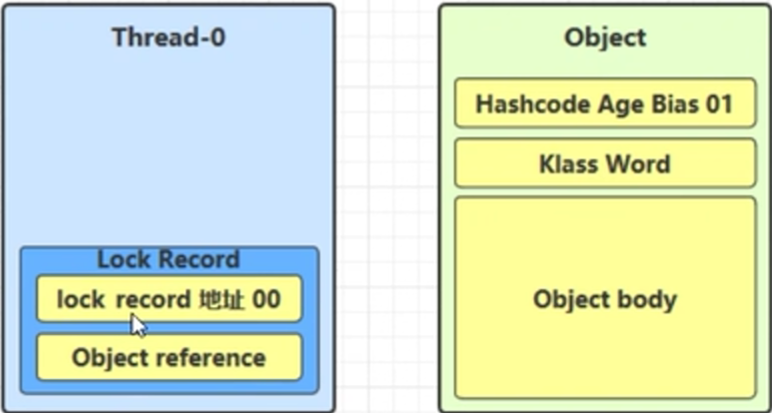
# 轻量级锁和重量级锁
# 锁膨胀
如果在尝试加轻量级锁的过程中,CAS 操作无法成功,这时一种情况就是有其它线程为此对象加上了轻量级锁(有 竞争),这时需要进行锁膨胀,将轻量级锁变为重量级锁。

对象头与栈帧中的锁记录交换/monitor
# 自旋优化
重量级锁竞争的时候,还可以使用自旋来进行优化,如果当前线程自旋成功(即这时候持锁线程已经退出了同步 块,释放了锁),这时当前线程就可以避免阻塞。 自旋重试成功的情况
# 偏向锁
撤销 - 调用对象 hashCode
撤销 - 其它线程使用对象
撤销 - 调用 wait/notify
# 批量重定向
# 批量撤销
# 锁粗化
锁粗化就是,对相同对象多次加锁,导致线程发生多次重入,可以使用锁粗化方式来优化,这不同于之前讲的细分锁的粒度。
当多个方法重复调用锁synchronized ,比如在for 循环中,就可以相当于在synchronized中进行for循环,进行粗化,锁的粒度变大
# 锁消除
# wait、notify(必须获得锁对象synchronized才能调用)
Owner 线程发现条件不满足,调用 wait 方法,即可进入 WaitSet 变为 WAITING 状态
BLOCKED 和 WAITING 的线程都处于阻塞状态,不占用 CPU 时间片
BLOCKED 线程会在 Owner 线程释放锁时唤醒
WAITING 线程会在 Owner 线程调用 notify 或 notifyAll 时唤醒,但唤醒后并不意味者立刻获得锁,仍需进入 EntryList 重新竞争
# wait/sleep 区别⭐
1、来自不同的类 wait => Object sleep => Thread 2、关于锁的释放 wait 会释放锁,sleep 睡觉了,抱着锁睡觉,不会释放 3、使用的范围是不同的 wait:必须在同步代码块中synchronized sleep:可以再任何地方睡 4、是否需要捕获异常 wait 不需要捕获异常 sleep 必须要捕获异常
sleep不能被唤醒,需要用wait
但是notify随机唤醒会导致虚假唤醒
# 防止虚假唤醒⭐
if 改为 while 判断
/**
* 线程之间的週信题:生产者和消赏者问题!等待唤,知唤
* 线程交替执行 A B操作问一个变量num=0
* A num+1
* B num-1
*/
public class A {
public static void main(String[] args) {
Data data = new Data();
new Thread(()->{
for (int i = 0; i < 10; i++) {
try {
data.increment();
} catch (InterruptedException e) {
e.printStackTrace();
}
}
},"A").start();
new Thread(()->{
for (int i = 0; i < 10; i++) {
try {
data.decrement();
} catch (InterruptedException e) {
e.printStackTrace();
}
}
},"B").start();
new Thread(()->{
for (int i = 0; i < 10; i++) {
try {
data.decrement();
} catch (InterruptedException e) {
e.printStackTrace();
}
}
},"C").start();
new Thread(()->{
for (int i = 0; i < 10; i++) {
try {
data.decrement();
} catch (InterruptedException e) {
e.printStackTrace();
}
}
},"D").start();
}
}
class Data{ //资源类
private int number=0;
public synchronized void increment() throws InterruptedException {
while(number!=0){
//等待
this.wait();
}
number++;
System.out.println(Thread.currentThread().getName()+"=>"+number);
//通知其他线程 +1完毕
this.notifyAll();
}
public synchronized void decrement() throws InterruptedException {
while(number==0){
//等待
this.wait();
}
number--;
System.out.println(Thread.currentThread().getName()+"=>"+number);
//通知其他线程 -1完毕
this.notifyAll();
}
}
# 死锁、活锁
死锁:互相持有对方的资源不释放导致
活锁:互相修改对方的结束条件导致不结束
# Lock 接口
公平锁:十分公平:可以先来后到 非公平锁:十分不公平:可以插队 (默认)
# Synchronized 和 Lock 区别⭐
1、Synchronized 内置的Java关键字, Lock 是一个Java类
2、Synchronized 无法判断获取锁的状态,Lock 可以判断是否获取到了锁
3、Synchronized 会自动释放锁,lock 必须要手动释放锁!如果不释放锁,死锁
4、Synchronized 线程 1(获得锁,阻塞)、线程2(等待,傻傻的等);Lock锁就不一定会等待下 去;
5、Synchronized 可重入锁,不可以中断的,非公平;Lock ,可重入锁,可以 判断锁,非公平(可以 自己设置);
6、Synchronized 适合锁少量的代码同步问题,Lock 适合锁大量的同步代码!
# synchronized和lock的区别
- synchronized是java关键字,lock是java类
- synchronized自动获取和释放锁,lock需要手动获取和释放
- synchronized是获取锁失败会一直等待的,lock不一定会一直等待
- synchronized无法判断锁的状态,lock可以判断是否获取到锁
- synchronized是可以重入的,不可中断,非公平,lock可重入,可以判断锁的状态就进行中断,可以指定为公平锁
- synchronized适合少量代码同步问题,lock适合大量的代码同步问题
reentrantlock可以设置条件变量,synchronized需要用notifyAll
# 锁是什么,如何判断锁的是谁⭐
# 保护性暂停
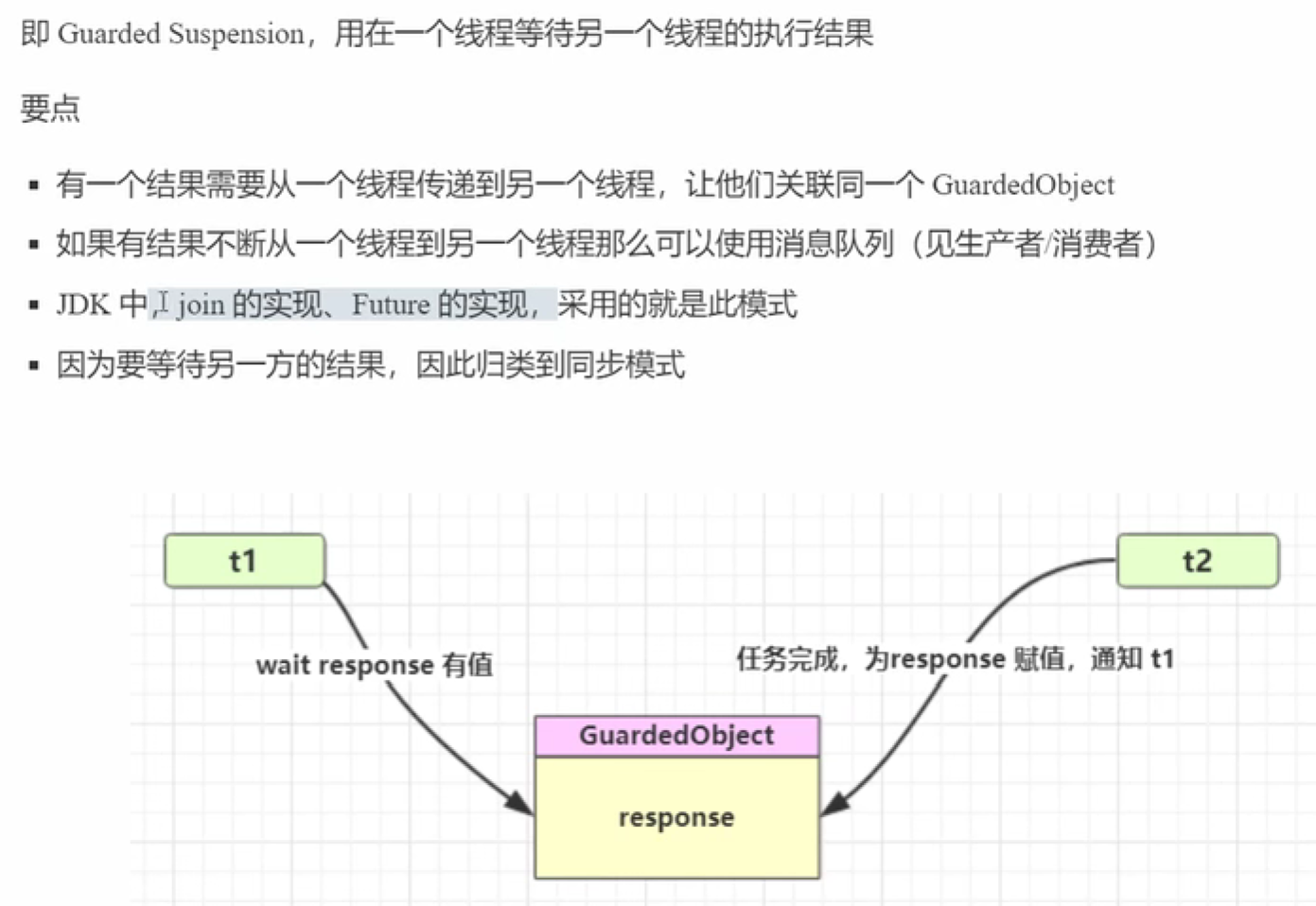
- 等待剩余时间
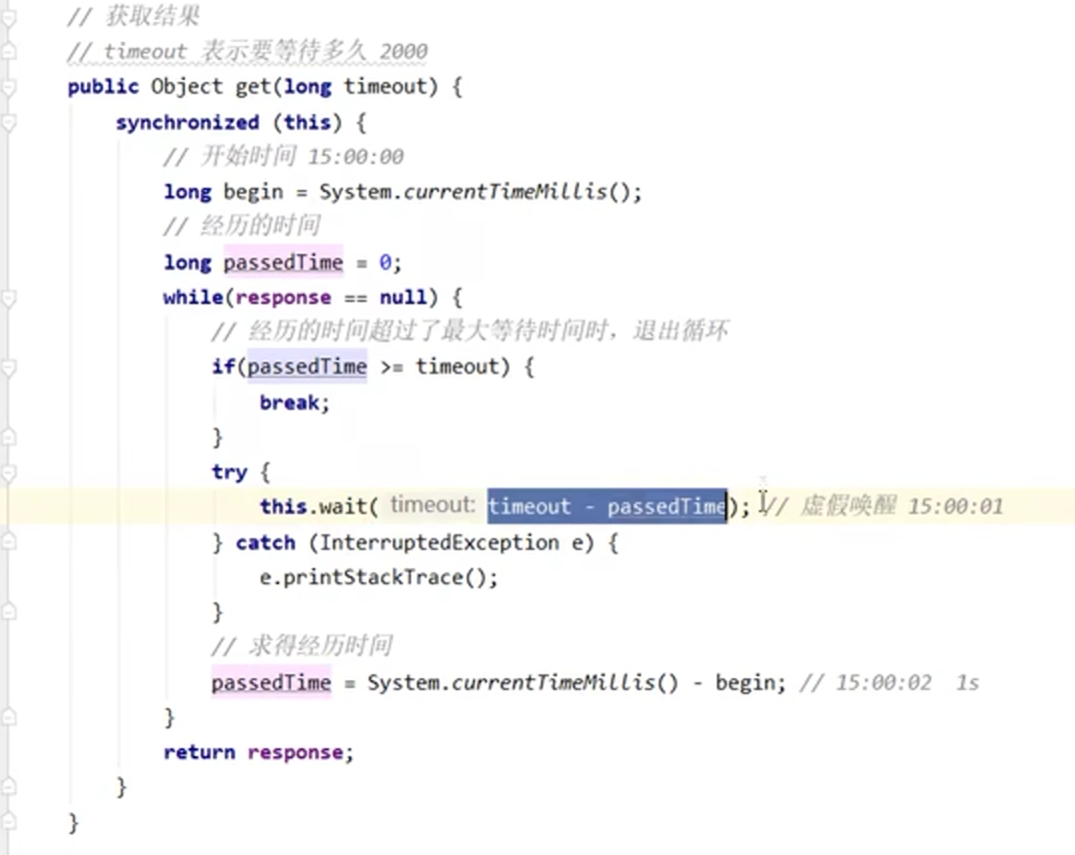
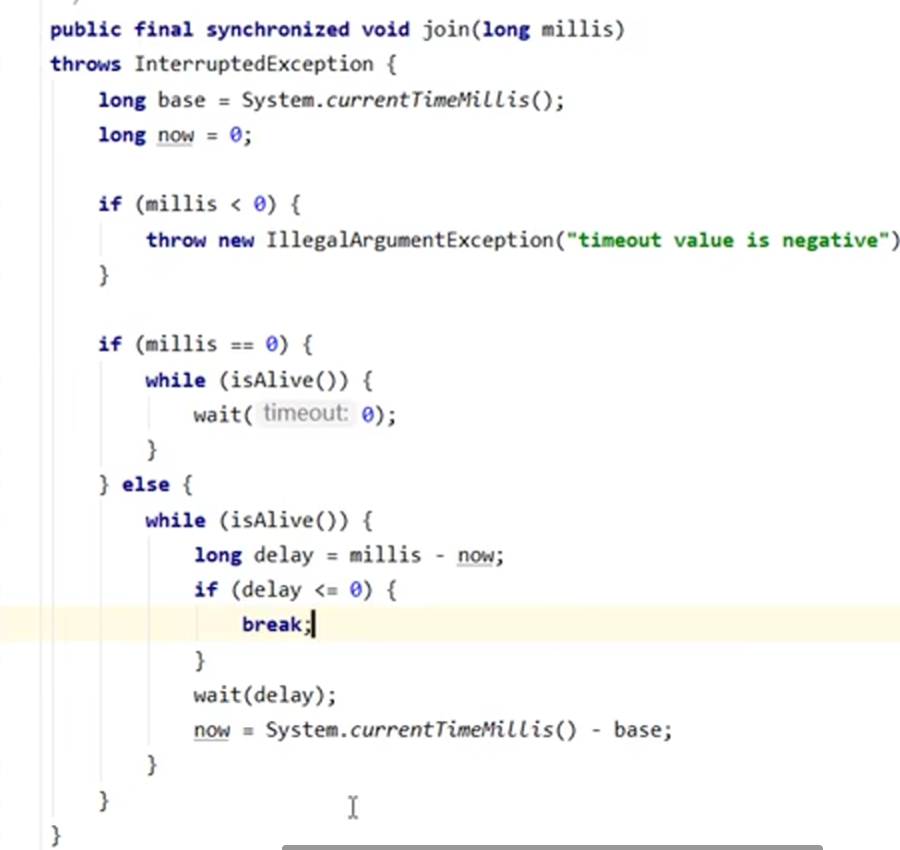
# 面试:单例模式、排序算法、生产者和消费者、死锁⭐⭐
# 生产者和消费者问题
# Synchronized
生产者和消费者问题 Synchronized 版
/**
* 线程之间的週信题:生产者和消赏者问题!等待唤,知唤 * 线程交替执行 A B操作问一个变量num=0 * A num+1 * B num-1
*/
public class A {
public static void main(String[] args) {
Data data = new Data();
new Thread(() -> {
for (int i = 0; i < 10; i++) {
try {
data.increment();
} catch (InterruptedException e) {
e.printStackTrace();
}
}
}, "A").start();
new Thread(() -> {
for (int i = 0; i < 10; i++) {
try {
data.decrement();
} catch (InterruptedException e) {
e.printStackTrace();
}
}
}, "B").start();
}
}
class Data { //资源类
private int number = 0;
public synchronized void increment() throws InterruptedException {
if (number != 0) { //等待
this.wait();
}
number++;
System.out.println(Thread.currentThread().getName() + "=>" + number); //通知其他线程 +1完毕
this.notifyAll();
}
public synchronized void decrement() throws InterruptedException {
if (number == 0) { //等待
this.wait();
}
number--;
System.out.println(Thread.currentThread().getName() + "=>" + number); //通知其他线程 -1完毕
this.notifyAll();
}
}
问题存在,A B C D 4 个线程! 虚假唤醒

# JUC
# JUC版的生产者和消费者问题
 通过Lock 找到 Condition
通过Lock 找到 Condition
代码实现:
/**
* 线程之间的週信题:生产者和消赏者问题!等待唤,知唤
* 线程交替执行 A B操作问一个变量num=0
* A num+1
* B num-1
*/
public class B {
public static void main(String[] args) {
Data2 data = new Data2();
new Thread(()->{
for (int i = 0; i < 10; i++) {
try {
data.increment();
} catch (InterruptedException e) {
e.printStackTrace();
}
}
},"A").start();
new Thread(()->{
for (int i = 0; i < 10; i++) {
try {
data.decrement();
} catch (InterruptedException e) {
e.printStackTrace();
}
}
},"B").start();
new Thread(()->{
for (int i = 0; i < 10; i++) {
try {
data.decrement();
} catch (InterruptedException e) {
e.printStackTrace();
}
}
},"C").start();
new Thread(()->{
for (int i = 0; i < 10; i++) {
try {
data.decrement();
} catch (InterruptedException e) {
e.printStackTrace();
}
}
},"D").start();
}
}
class Data2{ //资源类
private int number=0;
Lock lock=new ReentrantLock();
Condition condition = lock.newCondition();
public void increment() throws InterruptedException {
try {
lock.lock();
while(number!=0){
//等待
condition.await();
}
number++;
System.out.println(Thread.currentThread().getName()+"=>"+number);
//通知其他线程 +1完毕
//唤醒全部
condition.signalAll();
}catch (Exception e){
e.printStackTrace();
}finally {
lock.unlock();
}
}
public void decrement() throws InterruptedException {
try {
lock.lock();
while(number==0){
//等待
condition.await();
}
number--;
System.out.println(Thread.currentThread().getName()+"=>"+number);
//通知其他线程 -1完毕
//唤醒全部
condition.signalAll();
}catch (Exception e){
e.printStackTrace();
}finally {
lock.unlock();
}
}
}
任何一个新的技术,绝对不是仅仅只是覆盖了原来的技术,优势和补充!
# Condition ⭐
Condition 精准的通知和唤醒线程
/**
* 线程之间的週信题:生产者和消赏者问题!等待唤,知唤
* 线程交替执行 A B操作问一个变量num=0
* A num+1
* B num-1
* A 执行完 调用B B执行完调用C C执行完调用A
*/
public class C {
public static void main(String[] args) {
Data3 data = new Data3();
new Thread(()->{
for (int i = 0; i < 10; i++) {
try {
data.printA();
} catch (Exception e) {
e.printStackTrace();
}
}
},"A").start();
new Thread(()->{
for (int i = 0; i < 10; i++) {
try {
data.printB();
} catch (Exception e) {
e.printStackTrace();
}
}
},"B").start();
new Thread(()->{
for (int i = 0; i < 10; i++) {
try {
data.printC();
} catch (Exception e) {
e.printStackTrace();
}
}
},"C").start();
}
}
class Data3{ //资源类
private int number=1; //1A 2B 3C
Lock lock=new ReentrantLock();
Condition condition1 = lock.newCondition();
Condition condition2 = lock.newCondition();
Condition condition3 = lock.newCondition();
public void printA(){
lock.lock();
try {
while (number!=1){
//等待
condition1.await();
System.out.println(Thread.currentThread().getName()+"AAAAAA");
}
//唤醒指定的方法 B
number=2;
condition2.signal();
}catch (Exception e){
}finally {
lock.unlock();
}
}
public void printB(){
lock.lock();
try {
while (number!=2){
//等待
condition2.await();
System.out.println(Thread.currentThread().getName()+"BBBBBB");
}
//唤醒指定的方法 B
number=3;
condition3.signal();
}catch (Exception e){
}finally {
lock.unlock();//释放锁
}
}
public void printC(){
lock.lock();
try {
while (number!=3){
//等待
condition3.await();
System.out.println(Thread.currentThread().getName()+"CCCCCC");
}
//唤醒指定的方法 B
number=1;
condition1.signal();
}catch (Exception e){
}finally {
lock.unlock();//释放锁
}
}
}
# 8锁现象
# 场景1:同一个对象的静态同步方法和实例同步方法
静态同步方法使用的是类锁(EightLocksExample.class),而实例同步方法使用的是对象锁(example)。
这两个方法不会互相阻塞,可以并发执行。
# 场景2:不同对象的静态同步方法和实例同步方法
不会互相阻塞,可以并发执行
# 场景3:同一个对象的两个静态同步方法
使用的是同一个类锁(EightLocksExample.class),因此第二个线程必须等待第一个线程释放锁后才能继续执行。
# 场景4:不同对象的两个静态同步方法
使用的是同一个类锁(EightLocksExample.class)
# 场景5:同一个对象的两个实例同步方法
使用的是同一个对象锁(example)
# 场景6:不同对象的两个实例同步方法
使用的是不同的对象锁(example1 和 example2)
# 场景7:同一个对象的静态同步方法和实例同步方法,但其中一个方法加了额外的类锁同步块
EightLocksExample example = new EightLocksExample();
new Thread(() -> {
example.staticMethod();
}, "Thread-1").start();
new Thread(() -> {
synchronized (EightLocksExample.class) { // 使用类锁
example.instanceMethod();
}
}, "Thread-2").start();
等待
# 场景8:不同对象的静态同步方法和实例同步方法,但其中一个方法加了额外的对象锁同步块??
EightLocksExample example1 = new EightLocksExample();
EightLocksExample example2 = new EightLocksExample();
new Thread(() -> example1.staticMethod(), "Thread-1").start();
new Thread(() -> {
synchronized (example2) { // 使用另一个对象的锁
example2.instanceMethod();
}
}, "Thread-2").start();
不会互相阻塞,可以并发执行。
- 静态同步方法(static)使用类锁,即
ClassName.class,所有调用该静态同步方法的线程都会竞争同一个类锁。 - 实例同步方法使用对象锁,即
this,所有调用该实例同步方法的线程会竞争同一个对象实例的锁。 - 不同对象的实例同步方法不会互相阻塞,因为它们使用的是不同的对象锁。
- 同一对象的多个同步方法(无论是静态还是实例)会互相阻塞,因为它们使用的是同一个锁(类锁或对象锁)。
- 可以通过显式地使用同步块来控制锁的粒度,从而更灵活地管理线程间的同步关系。
/** *
* 8锁,就是关于锁的8个问题
*1、标准情况下,两个线程先打印 发短信还是 打电话? 1/发短信 2/打电话 * /
*1、sendSms延迟4秒,两个线程先打印 发短信还是 打电话? 1/发短信 2/打电话 */
public class Test1 {
public static void main(String[] args) {
phone phone = new phone();
//锁的存在
new Thread(()->{
phone.sendSms();
},"A").start();
try {
TimeUnit.SECONDS.sleep(1);
} catch (InterruptedException e) {
e.printStackTrace();
}
new Thread(()->{
phone.call();
},"B").start();
}
}
class phone{
// synchronized 锁的对象是方法的调用者!、
// 两个方法用的是同一个锁,谁先拿到谁执行!
public synchronized void sendSms(){
try {
TimeUnit.SECONDS.sleep(4);
} catch (InterruptedException e) {
e.printStackTrace();
}
System.out.println("sendSms");
}
public synchronized void call(){
System.out.println("call");
}
}
/** *
* 8锁,就是关于锁的8个问题
* 3、 增加了一个普通方法后!先执行发短信还是Hello? 普通方法 *
* 4、 两个对象,两个同步方法, 发短信还是 打电话? // 打电话
*/
public class Test2 {
public static void main(String[] args) {
//两个不同的对象 两把锁
phone2 phone = new phone2();
phone2 phone2 = new phone2();
//锁的存在
new Thread(()->{
phone.sendSms();
},"A").start();
try {
TimeUnit.SECONDS.sleep(1);
} catch (InterruptedException e) {
e.printStackTrace();
}
new Thread(()->{
phone2.call();
},"B").start();
/* new Thread(()->{
phone2.hello();
},"C").start();*/
}
}
class phone2{
// synchronized 锁的对象是方法的调用者!、
// 两个方法用的是同一个锁,谁先拿到谁执行!
public synchronized void sendSms(){
try {
TimeUnit.SECONDS.sleep(4);
} catch (InterruptedException e) {
e.printStackTrace();
}
System.out.println("sendSms");
}
public synchronized void call(){
System.out.println("call");
}
// 这里没有锁!不是同步方法,不受锁的影响
public void hello(){
System.out.println("hello");
}
}
/** *
* 8锁,就是关于锁的8个问题
*/
public class Test3 {
public static void main(String[] args) {
//static 类一加载就有了 所以锁定的是class
phone3 phone3 = new phone3();
//锁的存在
new Thread(()->{
phone3.sendSms();
},"A").start();
try {
TimeUnit.SECONDS.sleep(1);
} catch (InterruptedException e) {
e.printStackTrace();
}
new Thread(()->{
phone3.call();
},"B").start();
}
}
class phone3{
// synchronized 锁的对象是方法的调用者!、
// 两个方法用的是同一个锁,谁先拿到谁执行!
//static 类一加载就有了 所以锁定的是class
public static synchronized void sendSms(){
try {
TimeUnit.SECONDS.sleep(4);
} catch (InterruptedException e) {
e.printStackTrace();
}
System.out.println("sendSms");
}
public static synchronized void call(){
System.out.println("call");
}
}
/** *
* 8锁,就是关于锁的8个问题
*/
public class Test4 {
public static void main(String[] args) {
//static 类一加载就有了 所以锁定的是class
phone4 phone4 = new phone4();
//锁的存在
new Thread(()->{
phone4.sendSms();
},"A").start();
try {
TimeUnit.SECONDS.sleep(1);
} catch (InterruptedException e) {
e.printStackTrace();
}
new Thread(()->{
phone4.call();
},"B").start();
}
}
class phone4{
//静态的同步方法
public static synchronized void sendSms(){
try {
TimeUnit.SECONDS.sleep(4);
} catch (InterruptedException e) {
e.printStackTrace();
}
System.out.println("sendSms");
}
public synchronized void call(){
System.out.println("call");
}
}
# 线程安全分析
成员变量和静态变量是否线程安全?
- 如果它们没有共享,则线程安全
- 如果它们被共享了,根据它们的状态是否能够改变,又分两种情况
- ·如果只有读操作,则线程安全
- 如果有读写操作,则这段代码是临界区,需要考虑线程安全
局部变量是否线程安全?
- 局部变量是线程安全的
- 但局部变量引用的对象则未必
- 如果该对象没有逃离方法的作用访问,它是线程安全的
- 如果该对象逃离方法的作用范围,需要考虑线程安全
- 被子类继承后给其他线程调用,可以用final/private修饰解决
- 将局部变量传递出去做共享对象,X
成员变量在堆中,局部变量每个线程有一个局部变量表
# 常见的线程安全类
- String
- Integer
- StringBuffer,StringBuilder效率高但不安全
- Random
- Vector
- Hashtable
- java.util.concurrent的类
# 集合类不安全
# ConcurrentModificationException⭐
# List 不安全
并发下的List
public class ListUnSafe {
public static void main(String[] args) {
ArrayList<String> list = new ArrayList<>();
for (int i = 1; i <=10; i++) {
new Thread(()->{
list.add(UUID.randomUUID().toString().substring(0,5));
System.out.println(list);
},String.valueOf(i)).start();
}
}
}
运行报错
ArrayList的add底层代码 和 Vector的add底层代码
区别:就加了个synchronized 那JDK为什么不在ArrayList的add加上synchronized呢
并且Vector的出现比ArrayList要早 为了考虑效率问题所以去掉了synchronized
# 解决方案
- 使用Vector
- 使用Collections下的synchronizedList方法
- 使用JUC下的CopyOnWriteArrayList方法
public class ListUnSafe {
public static void main(String[] args) {
//List<String> list = new Vector<>();
//List<String> list=Collections.synchronizedList(new ArrayList<>());
List<String> list= new CopyOnWriteArrayList<>();
/**
* 解决方案:
* 1.List<String> list = new Vector<>();
* 2.List<String> list=Collections.synchronizedList(new ArrayList<>());
*
* Copywrite写入阿复制 COW 计算初程序设领域的一种优化策略
* 多个线程调用的时候,List读取的时候,固定的,写入(覆盖)
* 在写入的时候避免盖,造成数据问题
* 3.List<String> list= new CopyOnWriteArrayList<>();
*
* CopyOnWriteArrayList比Vector厉害在哪里 看源码
*/
for (int i = 1; i <=10; i++) {
new Thread(()->{
list.add(UUID.randomUUID().toString().substring(0,5));
System.out.println(list);
},String.valueOf(i)).start();
}
}
}
Vector的add方法
CopyOnWriteArrayList的add方法

CopyOnWriteArrayList比Vector厉害在哪里?⭐
- Vector是增删改查方法都加了synchronized保证同步,但是每个方法执行的时候都要去获得锁,性能就会大大下降
- 而CopyOnWriteArrayList 只是在增删改上加锁,但是读不加锁,在读方面的性能就好于Vector,CopyOnWriteArrayList支持读多写少的并发情况,读写分离,写时复制出一个新的数组,完成插入、修改或者移除操作后将新数组赋值给array
# Set不安全
多条线程执行set添加方法
public class SetUnSafe { public static void main(String[] args) { Set<String> set = new HashSet<>(); for (int i = 1; i <=30; i++) { new Thread(()->{ set.add(UUID.randomUUID().toString().substring(0,5)); System.out.println(set); },String.valueOf(i)).start(); } }}
报错,线程不安全
# 解决方案
- 使用Collections下的Collections.synchronizedSet(new HashSet<>());方法创建Set集合
- 使用JUC下的CopyOnWriteArraySet方法
public class SetUnSafe {
public static void main(String[] args) {
// Set<String> set = new HashSet<>();
//Set<String> set=Collections.synchronizedSet(new HashSet<>());
/**
* 解决方案
* 1. Set<String> set=Collections.synchronizedSet(new HashSet<>());
* 2. Set<String> set=new CopyOnWriteArraySet<>();
*
*/
Set<String> set=new CopyOnWriteArraySet<>();
for (int i = 1; i <=30; i++) {
new Thread(()->{
set.add(UUID.randomUUID().toString().substring(0,5));
System.out.println(set);
},String.valueOf(i)).start();
}
}
}
# HashSet底层是什么?
HashSet底层就是HashMap的底层实现原理,就只是加了个key不能被重复
public HashSet() {
map = new HashMap<>();
}
// add set本质就是 map key是无法重复的!
public boolean add(E e) {
return map.put(e, PRESENT)==null;
}
private static final Object PRESENT = new Object();//不变的值
# HashMap不安全
 并发异常测试
并发异常测试
public class MapUnSafe {
public static void main(String[] args) {
//map是这伴用的吗?不是,工作中不用 Hashmap
//就认等价于什么? new HashMap<>(16,0.75)
Map<String, String> map = new HashMap<>();
for (int i = 1; i <=10; i++) {
new Thread(()->{
map.put(Thread.currentThread().getName(),UUID.randomUUID().toString().substring(0,5));
System.out.println(map);
},String.valueOf(i)).start();
}
}
}
# 解决方案
- 使用Collections下的Collections.synchronizedMap(new HashMap<>());方法处理并发
- JUC下的ConcurrentHashMap方法
public class MapUnSafe {
public static void main(String[] args) {
//map是这伴用的吗?不是,工作中不用 Hashmap
//就认等价于什么? new HashMap<>(16,0.75)
// Map<String, String> map = new HashMap<>();
//Map<String, String> map = Collections.synchronizedMap(new HashMap<>());
/**
* 解决方案
* 1. Map<String, String> map = Collections.synchronizedMap(new HashMap<>());
* 2. Map<String, String> map = new ConcurrentHashMap<>();
*/
Map<String, String> map = new ConcurrentHashMap<>();
for (int i = 1; i <=10; i++) {
new Thread(()->{
map.put(Thread.currentThread().getName(),UUID.randomUUID().toString().substring(0,5));
System.out.println(map);
},String.valueOf(i)).start();
}
}
}
# 常用的辅助类(必会)
# CountDownLatch
public class CountDownLatchDemo {
public static void main(String[] args) throws InterruptedException {
// 总数是6,必须要执行任务的时候,再使用!
CountDownLatch countDownLatch = new CountDownLatch(6);
for (int i = 1; i <=6; i++) {
new Thread(()->{
System.out.println(Thread.currentThread().getName()+" Go out");
countDownLatch.countDown();// 数量-1
},String.valueOf(i)).start();
}
countDownLatch.await(); // 等待计数器归零,然后再向下执行
System.out.println("Close Door");
}
}
原理: countDownLatch.countDown(); // 数量-1
countDownLatch.await(); // 等待计数器归零,然后再向下执行 每次有线程调用 countDown() 数量-1,假设计数器变为0,countDownLatch.await() 就会被唤醒,继续 执行!
# CyclicBarrier
加法计数器
public class CyclicBarrierDemo {
public static void main(String[] args) {
/**
* 集齐7颗龙珠召唤神龙
*/
CyclicBarrier cyclicBarrier = new CyclicBarrier(7, () -> {
System.out.println("召唤神龙成功");
});
for (int i = 1; i <=7; i++) {
final int temp=i;
new Thread(()->{
System.out.println(Thread.currentThread().getName()+"收集了"+temp+"个龙珠");
try {
cyclicBarrier.await();//等待
} catch (InterruptedException e) {
e.printStackTrace();
} catch (BrokenBarrierException e) {
e.printStackTrace();
}
}).start();
}
}
}
# Semaphore
Semaphore:信号量
public class SemaphoreDemo {
public static void main(String[] args) {
// 限流
Semaphore semaphore = new Semaphore(3);
for (int i = 1; i <=6; i++) {
new Thread(()->{
//acquire()得到
try {
semaphore.acquire();
System.out.println(Thread.currentThread().getName()+"得到车位");
TimeUnit.SECONDS.sleep(2);
System.out.println(Thread.currentThread().getName()+"离开车位");
} catch (InterruptedException e) {
e.printStackTrace();
}finally {
semaphore.release(); // release() 释放
}
},String.valueOf(i)).start();
}
}
}
原理:
- semaphore.acquire() 获得,假设如果已经满了,等待,等待被释放为止!
- semaphore.release(); 释放,会将当前的信号量释放 + 1,然后唤醒等待的线程!
作用: 多个共享资源互斥的使用!并发限流,控制大的线程数!
# 读写锁
# ReadWriteLock
/**独占锁(写锁)
* 一次只能被一个线程占有
* 共享锁(读锁) 多个线程可以同时占有
*
* ReadWriteLock
* 读-读 可以共存!
* 读-写 不能共存!
* 写-写 不能共存!
*/
public class ReadWriteLockDemo {
public static void main(String[] args) {
MyCacheLock myCache = new MyCacheLock();
for (int i = 1; i <= 5; i++) {
int temp=i;
new Thread(()->{
myCache.put(temp+"",temp+"");
},String.valueOf(i)).start();
}
for (int i = 1; i <= 5; i++) {
int temp=i;
new Thread(()->{
myCache.get(temp+"");
},String.valueOf(i)).start();
}
}
}
//加锁
class MyCacheLock{
private volatile Map<String,Object> map= new HashMap<>();
//读写锁:
private ReadWriteLock readWriteLock= new ReentrantReadWriteLock();
//存 写入的时候 只能有一个线程写入
public void put(String key,Object value){
readWriteLock.writeLock().lock();
try {
System.out.println(Thread.currentThread().getName()+"写入"+key);
map.put(key,value);
System.out.println(Thread.currentThread().getName()+"写入ok");
}catch (Exception e){
e.printStackTrace();
}finally {
readWriteLock.writeLock().unlock();
}
}
//读的时候允许多个线程
public void get(String key){
readWriteLock.readLock().lock();
try {
System.out.println(Thread.currentThread().getName()+"读取"+key);
map.get(key);
System.out.println(Thread.currentThread().getName()+"读取ok");
} catch (Exception e) {
e.printStackTrace();
} finally {
readWriteLock.readLock().unlock();
}
}
}
//自定义缓存 没有加锁
class MyCache{
private volatile Map<String,Object> map= new HashMap<>();
public void put(String key,Object value){
System.out.println(Thread.currentThread().getName()+"写入"+key);
map.put(key,value);
System.out.println(Thread.currentThread().getName()+"写入ok");
}
public void get(String key){
System.out.println(Thread.currentThread().getName()+"读取"+key);
map.get(key);
System.out.println(Thread.currentThread().getName()+"读取ok");
}
}
# 阻塞队列
什么情况下我们会使用 阻塞队列:多线程并发处理,线程池! 学会使用队列 添加、移除
# BlockingQueue
四组API⭐
| 方法 | 抛出异常 | 有返回值,不抛出异常 | 阻塞等待 | 超时等待 |
|---|---|---|---|---|
| 添加 | add() | offer() | put() | offer(,,) |
| 移除 | remove() | poll() | take() | poll(,) |
| 检测队首元素 | element() | peek() | - | - |
# 会抛出异常
public class Test {
/**
* 抛出异常
*/
public void test1(){
//队列的大小
ArrayBlockingQueue arrayBlockingQueue = new ArrayBlockingQueue<>(3);
System.out.println(arrayBlockingQueue.add("a"));
System.out.println(arrayBlockingQueue.add("b"));
System.out.println(arrayBlockingQueue.add("c"));
/**
* IllegalStateException抛出异常
* System.out.println(arrayBlockingQueue.add("d"));
*/
System.out.println(arrayBlockingQueue.remove());
System.out.println(arrayBlockingQueue.remove());
System.out.println(arrayBlockingQueue.remove());
/**队列大小只有3
* NoSuchElementException抛出异常
* System.out.println(arrayBlockingQueue.remove());
*/
}
}
# 有返回值 不会抛出异常
/**
* 有返回值 不会抛出异常
*/
public void test2(){
//队列的大小
ArrayBlockingQueue arrayBlockingQueue = new ArrayBlockingQueue<>(3);
System.out.println(arrayBlockingQueue.offer("a"));
System.out.println(arrayBlockingQueue.offer("b"));
System.out.println(arrayBlockingQueue.offer("c"));
System.out.println(arrayBlockingQueue.offer("d"));
System.out.println(arrayBlockingQueue.poll());
System.out.println(arrayBlockingQueue.poll());
System.out.println(arrayBlockingQueue.poll());
System.out.println(arrayBlockingQueue.poll());
}
# 检测队首元素
System.out.println("队首是"+arrayBlockingQueue.element());//检测队首元素 会抛出异常
System.out.println("队首是"+arrayBlockingQueue.peek());//检测队首元素 不会抛出异常
# 等待 阻塞
/**
* 等待 阻塞
*
*/
public void test4() throws InterruptedException {
ArrayBlockingQueue arrayBlockingQueue = new ArrayBlockingQueue<>(3);
arrayBlockingQueue.put("a");
arrayBlockingQueue.put("b");
arrayBlockingQueue.put("c");
//队列没有位置 d 会一值等待
//arrayBlockingQueue.put("d");
System.out.println(arrayBlockingQueue.take());
System.out.println(arrayBlockingQueue.take());
System.out.println(arrayBlockingQueue.take());
// 没有元素 会一直等待
System.out.println(arrayBlockingQueue.take());
}
# 超时等待 自动退出
/**
* 超时等待
*
*/
public void test5() throws InterruptedException {
ArrayBlockingQueue arrayBlockingQueue = new ArrayBlockingQueue<>(3);
System.out.println(arrayBlockingQueue.offer("a"));
System.out.println(arrayBlockingQueue.offer("b"));
System.out.println(arrayBlockingQueue.offer("c"));
System.out.println(arrayBlockingQueue.offer("d",2, TimeUnit.SECONDS));//等待超过两秒后 就退出
System.out.println(arrayBlockingQueue.poll());
System.out.println(arrayBlockingQueue.poll());
System.out.println(arrayBlockingQueue.poll());
System.out.println(arrayBlockingQueue.poll(2,TimeUnit.SECONDS));//等待超过两秒后 就退出
}
# SynchronizedQueue
没有容量, 进去一个元素,必须等待取出来之后,才能再往里面放一个元素! put、take
/**
* 同步队列
* 和其他的BlockingQueue 不一样, SynchronousQueue 不存储元素
* put了一个元素,必须从里面先take取出来,否则不能在put进去值!
*/
public class SynchronousQueueDemo {
public static void main(String[] args) {
BlockingQueue<String> blockingQueue = new SynchronousQueue<>(); // 同步队列
new Thread(()->{
try {
System.out.println(Thread.currentThread().getName() + "put 1");
blockingQueue.put("1");
System.out.println(Thread.currentThread().getName() + "put 2");
blockingQueue.put("2");
System.out.println(Thread.currentThread().getName() + "put 3");
blockingQueue.put("3");
} catch (InterruptedException e) {
e.printStackTrace();
}
},"T1").start();
new Thread(()->{
try {
TimeUnit.SECONDS.sleep(3);
System.out.println(Thread.currentThread().getName()+"=>"+blockingQueue.take());
TimeUnit.SECONDS.sleep(3);
System.out.println(Thread.currentThread().getName()+"=>"+blockingQueue.take());
TimeUnit.SECONDS.sleep(3);
System.out.println(Thread.currentThread().getName()+"=>"+blockingQueue.take());
} catch (InterruptedException e) {
e.printStackTrace();
}
},"T2").start();
}
}
# 线程池
池化技术
程序的运行,本质:占用系统的资源! 优化资源的使用!=>池化技术 线程池、连接池、内存池、对象池///….. 创建、销毁。十分浪费资源 池化技术:事先准备好一些资源,有人要用,就来我这里拿,用完之后还给我。
线程池的好处: 1、降低资源的消耗 2、提高响应的速度 3、方便管理。
==线程复用、可以控制最大并发数、管理线程==
ExecutorService 提供了两种主要方法来提交任务:submit() 和 execute()。
# execute
execute(Runnable command)
- 功能:用于执行一个没有返回值的任务。
- 参数:接受一个
Runnable对象。 - 返回值:无(
void)。 - 异常处理:任何未捕获的异常都会导致线程终止,并且无法通过调用方法直接获取这些异常信息。
# submit
submit(Callable<V> task) 或 submit(Runnable task, V result)
- 功能:用于执行一个可以返回结果或抛出异常的任务。
- 参数:可以接受一个
Callable或带有结果参数的Runnable。 - 返回值:返回一个
Future<V>对象,可以通过这个对象获取任务的结果、检查任务状态或取消任务。 - 异常处理:如果任务抛出了异常,可以通过
Future.get()方法捕获并处理这些异常。
# 三个方法
不要使用Executor的三个方法SingleThreadExecutor、FixThreadExecutor、CachedThreadExecutor底层都是调用ThreadPoolExecutor
直接使用new ThreadPoolExecutor(七个参数)
public class Demo1 {
public static void main(String[] args) {
// ExecutorService ThreadPool = Executors.newSingleThreadExecutor();//单个线程
// ExecutorService ThreadPool = Executors.newFixedThreadPool(5);// 创建一 个固定的线程池的大小
ExecutorService ThreadPool = Executors.newCachedThreadPool();// 可伸缩 的,遇强则强,遇弱则弱
try {
for (int i = 0; i < 10; i++) {
ThreadPool.execute(()->{//使用了线程池之后,使用线程池来创建线程
System.out.println(Thread.currentThread().getName());
});
}
}catch (Exception e){
e.printStackTrace();
}finally {
// 线程池用完,程序结束,关闭线程池
ThreadPool.shutdown();
}
}
}
本质调用的是ThreadPoolExecutor
public ThreadPoolExecutor(int corePoolSize,//核心线程池大小
int maximumPoolSize,//最大核心线程池大小
long keepAliveTime,//超时了没有人调用就会释放
TimeUnit unit,//超时单位
BlockingQueue<Runnable> workQueue,//拒绝策略
ThreadFactory threadFactory//线程工厂,创建线程的) {
this(corePoolSize, maximumPoolSize, keepAliveTime, unit, workQueue,
threadFactory, defaultHandler);
}
# 七大参数
corePoolSize:核心线程数。
maximumPoolSize:最大线程数。
keepAliveTime:空闲线程存活时间。
TimeUnit:时间单位。
BlockingQueue:线程池任务队列。
ThreadFactory:创建线程的工厂。
RejectedExecutionHandler:拒绝策略。
手动创建一个线程池
默认拒绝策略
public class Demo1 {
public static void main(String[] args) {
// ExecutorService ThreadPool = Executors.newSingleThreadExecutor();//单个线程
//ExecutorService ThreadPool = Executors.newFixedThreadPool(5);// 创建一 个固定的线程池的大小
//ExecutorService ThreadPool = Executors.newCachedThreadPool();// 可伸缩 的,遇强则强,遇弱则弱
ThreadPoolExecutor ThreadPool = new ThreadPoolExecutor(
2,//核心线程池大小
5,//最大核心线程池大小
3,//超时了没有人调用就会释放
TimeUnit.SECONDS,//超时单位
new LinkedBlockingQueue<>(3),
Executors.defaultThreadFactory(),//线程工厂,创建线程的
new ThreadPoolExecutor.AbortPolicy()//默认的拒绝策略
);
/**
* RejectedExecutionException 拒绝策略异常
*/
try {
for (int i = 1; i <=8; i++) {
ThreadPool.execute(()->{//使用了线程池之后,使用线程池来创建线程
System.out.println(Thread.currentThread().getName());
});
}
}catch (Exception e){
e.printStackTrace();
}finally {
// 线程池用完,程序结束,关闭线程池
ThreadPool.shutdown();
}
}
}
# 四种拒绝策略
AbortPolicy:这是线程池的默认拒绝策略。当任务无法被线程池执行时,会抛出RejectedExecutionException异常。
CallerRunsPolicy:当任务无法被线程池执行时,会直接在调用者线程中运行这个任务。如果调用者线程正在执行一个任务,则会创建一个新线程来执行被拒绝的任务。
DiscardPolicy:当任务无法被线程池执行时,任务将被丢弃,不抛出异常,也不执行任务。
DiscardOldestPolicy:当任务无法被线程池执行时,线程池会丢弃队列中最旧的任务,然后尝试再次提交当前任务。
/** new ThreadPoolExecutor.AbortPolicy() // 银行满了,还有人进来,不处理这个人的,抛出异 常
* new ThreadPoolExecutor.CallerRunsPolicy() // 哪来的去哪里!
* new ThreadPoolExecutor.DiscardPolicy() //队列满了,丢掉任务,不会抛出异常!
* new ThreadPoolExecutor.DiscardOldestPolicy() //队列满了,尝试去和早的竞争,也不会 抛出异常!
* */
# 四大函数式接口(必需掌握)⭐
新时代的程序员:lambda表达式、链式编程、函数式接口、Stream流式计算
函数式接口: 只有一个方法的接口
@FunctionalInterface
public interface Runnable {
public abstract void run();
}
// 泛型、枚举、反射
// lambda表达式、链式编程、函数式接口、Stream流式计算
// 超级多FunctionalInterface
// 简化编程模型,在新版本的框架底层大量应用!
// foreach(消费者类的函数式接口)
# Function函数式接口
/**
* 函数型接口
*/
public class Demo01 {
public static void main(String[] args) {
/* Function<String,String> function = new Function<String, String>() {
@Override
public String apply(String s) {
return null;
}
};*/
//lamda表达式
Function<String,String> function = (str)->{return str;};
System.out.println(function.apply("asd"));
}
}
# 断定型接口
有一个输入参数,返回值只能是 布尔值!
public class Demo2 {
public static void main(String[] args) {
/*Predicate<String> predicate = new Predicate<String>() {
// 判断字符串是否为空
@Override
public boolean test(String s) {
return s.isEmpty();
}
};*/
Predicate<String> predicate = (str)->{return str.isEmpty(); };
System.out.println(predicate.test(""));
}
}
# Consumer 消费型接口
/**
* Consumer 消费型接口: 只有输入,没有返回值
*/
public class Demo3 {
public static void main(String[] args) {
/* Consumer<String> consumer = new Consumer<String>() {
@Override
public void accept(String o) {
System.out.println(o);
}
};*/
Consumer<String> consumer = (str)->{System.out.println(str);};
consumer.accept("sss");
}
}
# Supplier 供给型接口
/**
* Supplier 供给型接口
*/
public class Demo4 {
public static void main(String[] args) {
/* Supplier<Integer> supplier = new Supplier<Integer>() {
@Override
public Integer get() {
return 1024;
}
};*/
Supplier supplier = ()->{ return 1024; };
System.out.println(supplier.get());
}
}
# Stream流式计算⭐
什么是Stream流式计算
大数据:存储 + 计算 集合、MySQL 本质就是存储东西的; 计算都应该交给流来操作!
/**
* 题目要求:一分钟内完成此题,只能用一行代码实现!
* 现在有5个用户!筛选:
* 1、ID 必须是偶数
* 2、年龄必须大于23岁
* 3、用户名转为大写字母
* 4、用户名字母倒着排序
* 5、只输出一个用户!
**/
public class StreamPage {
public static void main(String[] args) {
User user1 = new User(1,"张三",21);
User user2 = new User(2,"李四",25);
User user3 = new User(3,"王五",22);
User user4 = new User(4,"赵六",23);
User user5 = new User(5,"孙七",24);
// 集合就是存储
List<User> list= Arrays.asList(user1,user2,user3,user4,user5);
// 计算交给Stream流
// lambda表达式、链式编程、函数式接口、Stream流式计算
list.stream()
.filter(user -> {return user.getId()%2==0;})//1、ID 必须是偶数
.filter(user -> {return user.getAge()>23;})//2、年龄必须大于23岁
.map(user -> {return user.getName().toUpperCase();})//3、用户名转为大写字母
.sorted((u1,u2)->{return u2.compareTo(u1);})//4、用户名字母倒着排序
.limit(1)//5、只输出一个用户!
.forEach(System.out::println);
}
}
@Data
@AllArgsConstructor
class User{
private int Id;
private String name;
private int age;
}
# ForkJoin
Java 7 引入的一种并行编程框架,旨在通过分治法(Divide and Conquer)来高效地执行任务。
ForkJoin 框架的核心类
ForkJoinPool
ForkJoinTask,
- 常用的两种任务类型
RecursiveTask<V>- 返回结果的任务。
RecursiveAction- 不返回结果的任务。
fork() 和 join()
- 启动子任务和等待子任务完成。
- fork():安排一个新的任务异步执行。
- join():等待子任务完成并获取其结果(对于
RecursiveTask)或只是等待完成(对于RecursiveAction)。
/**
* 求和计算的任务!
* 3000 6000(ForkJoin) 9000(Stream并行流)
* 如何使用 forkjoin
* 1、forkjoinPool 通过它来执行
* 2、计算任务 forkjoinPool.execute(ForkJoinTask task)
* 3. 计算类要继承 ForkJoinTask
* */
public class ForkJoinDemo extends RecursiveTask<Long> {
private Long start; // 1
private Long end; // 1990900000
// 临界值
private Long temp = 10000L;
public ForkJoinDemo(Long start, Long end) {
this.start = start;
this.end = end;
}
/**
* 计算方法
* @return
*/
@Override
protected Long compute() {
if((end-start)<temp){
Long sum=0L;
for (Long i = start; i < end; i++) {
sum+=i;
}
return sum;
}else { // forkjoin 递归
long middle = (start + end) / 2; // 中间值
ForkJoinDemo task1 = new ForkJoinDemo(start, middle);
task1.fork(); // 拆分任务,把任务压入线程队列
ForkJoinDemo task2 = new ForkJoinDemo(middle+1, end);
task2.fork(); // 拆分任务,把任务压入线程队列
return task1.join() + task2.join();
}
}
}
# Future
# CompletableFuture
# runAsync
用于执行不返回结果的任务,
public static CompletableFuture<Void> runAsync(Runnable runnable)
public static CompletableFuture<Void> runAsync(Runnable runnable, Executor executor)
# SupplyAsync
执行返回结果的任务,
public static <U> CompletableFuture<U> supplyAsync(Supplier<U> supplier)
public static <U> CompletableFuture<U> supplyAsync(Supplier<U> supplier, Executor executor)
/**
* 异步调用: CompletableFuture
* 异步执行
* 成功回调
* 失败回调
* */
public class FutureDemo {
public static void main(String[] args) throws ExecutionException, InterruptedException {
//发送一个请求
// 没有返回值的 runAsync 异步回调
/* CompletableFuture<Void> completableFuture = CompletableFuture.runAsync(() -> {
try {
TimeUnit.SECONDS.sleep(2);
} catch (InterruptedException e) {
e.printStackTrace();
}
System.out.println(Thread.currentThread().getName()+"runAsync=>void");
});
System.out.println("1111");
completableFuture.get();//获取阻塞执行结果*/
// 有返回值的 supplyAsync 异步回调
// ajax,成功和失败的回调
// 返回的是错误信息;
CompletableFuture<Integer> completableFuture = CompletableFuture.supplyAsync(()->{
System.out.println(Thread.currentThread().getName()+"supplyAsync=>Integer");
int i = 10/0;
return 200;
});
System.out.println(completableFuture.whenComplete((t, u) -> {
System.out.println("t=>" + t); // 正常的返回结果
System.out.println("u=>" + u); // 错误信息: java.util.concurrent.CompletionException: java.lang.ArithmeticException: / by zero
}).exceptionally((e) -> {
System.out.println(e.getMessage());
return 505; // 可以获取到错误的返回结果
}).get());
}
}
# JMM⭐⭐
JAVA 内存模型(java memory model)。
因为在不同的硬件生产商和不同的操作系统下,内存的访问逻辑有一定的差异,结果就是当你的代码在某个系统环境下运行良好,并且线程安全,但是换了个系统就出现各种问题。
Java内存模型,就是为了屏蔽系统和硬件的差异,让一套代码在不同平台下能到达相同的访问结果。
JVM在设计时候考虑到,如果JAVA线程每次读取和写入变量都直接操作主内存,对性能影响比较大,所以每条线程拥有各自的工作内存,工作内存中的变量是主内存中的一份拷贝,线程对变量的读取和写入,直接在工作内存中操作,而不能直接去操作主内存中的变量。但是这样就会出现一个问题,当一个线程修改了自己工作内存中变量,对其他线程是不可见的,会导致线程不安全的问题。因为JMM制定了一套标准来保证开发者在编写多线程程序的时候,能够控制什么时候内存会被同步给其他线程。
JMM : Java内存模型,不存在的东西,概念!约定!
关于JMM的一些同步的约定: 1、线程解锁前,必须把共享变量立刻刷回主存。 2、线程加锁前,必须读取主存中的新值到工作内存中! 3、加锁和解锁是同一把锁
线程 工作内存 、主内存
8种操作:
# 内存交互操作
内存交互操作有8种,虚拟机实现必须保证每一个操作都是原子的,不可在分的(对于double和long类 型的变量来说,load、store、read和write操作在某些平台上允许例外)
- lock (锁定):作用于主内存的变量,把一个变量标识为线程独占状态
- unlock (解锁):作用于主内存的变量,它把一个处于锁定状态的变量释放出来,释放后的变量才可以被其他线程锁定
- read (读取):作用于主内存变量,它把一个变量的值从主内存传输到线程的工作内存中,以便随后的load动作使用
- load (载入):作用于工作内存的变量,它把read操作从主存中变量放入工作内存中
- use (使用):作用于工作内存中的变量,它把工作内存中的变量传输给执行引擎,每当虚拟机遇到一个需要使用到变量的值,就会使用到这个指令
- assign (赋值):作用于工作内存中的变量,它把一个从执行引擎中接受到的值放入工作内存的变量副本中
- store (存储):作用于主内存中的变量,它把一个从工作内存中一个变量的值传送到主内存中,以便后续的write使用
- write (写入):作用于主内存中的变量,它把store操作从工作内存中得到的变量的值放入主内存的变量中
JMM对这八种指令的使用,制定了如下规则:
- 不允许read和load、store和write操作之一单独出现。即使用了read必须load,使用了store必须write
- 不允许线程丢弃他最近的assign操作,即工作变量的数据改变了之后,必须告知主存
- 不允许一个线程将没有assign的数据从工作内存同步回主内存
- 一个新的变量必须在主内存中诞生,不允许工作内存直接使用一个未被初始化的变量。就是怼变量实施use、store操作之前,必须经过assign和load操作
- 一个变量同一时间只有一个线程能对其进行lock。多次lock后,必须执行相同次数的unlock才能解锁
- 如果对一个变量进行lock操作,会清空所有工作内存中此变量的值,在执行引擎使用这个变量前,必须重新load或assign操作初始化变量的值
- 如果一个变量没有被lock,就不能对其进行unlock操作。也不能unlock一个被其他线程锁住的变量
- 对一个变量进行unlock操作之前,必须把此变量同步回主内存
# Volatile&synchronized⭐
volatile是java虚拟机提供的轻量级同步机制
保证可见性
不保证原子性
禁止指令重排
synchronized
保证可见性
保证原子性
禁止指令重排
不使用synchronized和lock怎么保证原子性
- atomicInteger
- getAndIncrement()
- 底层与操作系统有关,直接修改内存的值
- atomicInteger
# 保证可见性
# synchronized
synchronized也可以保证可见性
public class JMMDemo {
// 不加 volatile 程序就会死循环!
// 加 volatile 可以保证可见性
private volatile static int num = 0;
public static void main(String[] args) {
new Thread(() -> { // 线程 1 对主内存的变化不知道的
while (num == 0) {
}
}).start();
try {
TimeUnit.SECONDS.sleep(1);
} catch (InterruptedException e) {
e.printStackTrace();
}
num = 1;
System.out.println(num);
}
}
# 不保证原子性
原子性 : 不可分割 线程A在执行任务的时候,不能被打扰的,也不能被分割。要么同时成功,要么同时失败
public class VDemo02 {
private volatile static int num = 0;
public static void add(){
num++;
}
public static void main(String[] args) {
//理论上num结果应该为 2 万
for (int i = 1; i <= 20; i++) {
new Thread(()->{
for (int j = 0; j < 1000; j++) {
add();
}
}).start();
}
while (Thread.activeCount() > 2) {
Thread.yield();
}
System.out.println(Thread.currentThread().getName() + "" + num);
}
}
如果不加 lock 和 synchronized ,怎么样保证原子性
使用原子类,解决 原子性问题
public class VDemo02 {
// 原子类的 Integer
private volatile static AtomicInteger num = new AtomicInteger();
public static void add(){
// num++;
num.getAndIncrement(); // AtomicInteger + 1 方法, CAS
}
public static void main(String[] args) {
//理论上num结果应该为 2 万
for (int i = 1; i <= 20; i++) {
new Thread(()->{
for (int j = 0; j < 1000; j++) {
add();
}
}).start();
}
while (Thread.activeCount() > 2) {
Thread.yield();
}
System.out.println(Thread.currentThread().getName() + "" + num);
}
}
# 指令重排
什么是 指令重排:你写的程序,计算机并不是按照你写的那样去执行的。 源代码—>编译器优化的重排—> 指令并行也可能会重排—> 内存系统也会重排—-> 执行 处理器在进行指令重排的时候,考虑:数据之间的依赖性!
volatile可以避免指令重排: 内存屏障。CPU指令。作用: 1、保证特定的操作的执行顺序! 2、可以保证某些变量的内存可见性 (利用这些特性volatile实现了可见性)
Volatile 是可以保持 可见性。不能保证原子性,由于内存屏障,可以保证避免指令重排的现象产生
# 内存屏障
内存屏障主要分为以下几类:
- LoadLoad 屏障:
- 确保在此屏障之前的读操作(Load)先于在此屏障之后的读操作完成。
- 语法示例:
LoadLoad
- StoreStore 屏障:
- 确保在此屏障之前的写操作(Store)先于在此屏障之后的写操作完成。
- 语法示例:
StoreStore
- LoadStore 屏障:
- 确保在此屏障之前的读操作(Load)先于在此屏障之后的写操作(Store)完成。
- 语法示例:
LoadStore
- StoreLoad 屏障:
- 确保在此屏障之前的写操作(Store)先于在此屏障之后的读操作(Load)完成。
- 这是最常用的屏障类型之一,因为它不仅防止了写操作和读操作之间的重排序,还确保了写操作对其他线程的可见性。
- 语法示例:
StoreLoad
# volatile
在写入 volatile 变量时,JVM会在写操作之前插入一个 StoreStore 屏障,并在写操作之后插入一个 StoreLoad 屏障。
在读取 volatile 变量时,JVM会在读操作之前插入一个 LoadLoad 屏障,并在读操作之后插入一个 LoadStore 屏障。
写屏障(sfence)
保证在该屏障之前的,对共享变量的改动,都同步到主存当中
public void actor2(I_Result r){
num 2;
ready = true;//ready是volatile赋值带写屏暗
//写屏障
}
而读屏障(lfence) 保证在该屏障之后,对共享变量的读取,加载的是主存中最新数据
public void actor1(I_Result r){
//读屏障
//ready是volati1e读取值带读屏障
if(ready){
r.r1 = num + num;
}
else{
r.r1=1;
}
}
# synchronized
进入 synchronized 块时,JVM会插入一个 MonitorEnter 指令,相当于一个内存屏障。
退出 synchronized 块时,JVM会插入一个 MonitorExit 指令,也相当于一个内存屏障。
# 彻底玩转单例模式⭐⭐
饿汉式 DCL懒汉式,深究!
# 饿汉式
public class Hungry {
private byte[] data1 = new byte[1024*1024];
private byte[] data2 = new byte[1024*1024];
private byte[] data3 = new byte[1024*1024];
private byte[] data4 = new byte[1024*1024];
private Hungry(){
}
private final static Hungry HUNGRY = new Hungry();
public static Hungry getInstance(){
return HUNGRY;
}
}
// 问题1:为什么加 final
// 问题2:如果实现了序列化接口, 还要做什么来防止反序列化破坏单例
public final class Singleton implements Serializable {
// 问题3:为什么设置为私有? 是否能防止反射创建新的实例?
private Singleton() {}
// 问题4:这样初始化是否能保证单例对象创建时的线程安全?
private static final Singleton INSTANCE = new Singleton();
// 问题5:为什么提供静态方法而不是直接将 INSTANCE 设置为 public, 说出你知道的理由
public static Singleton getInstance() {
return INSTANCE;
}
public Object readResolve() {
return INSTANCE;
}
}
# DCL 懒汉式
public class LazyMan {
private static boolean joker = false;
private LazyMan(){
synchronized (LazyMan.class){
if (joker == false){
joker = true;
}else {
throw new RuntimeException("不要试图使用反射破坏异常");
}
}
}
private volatile static LazyMan lazyMan;
// 双重检测锁模式的 懒汉式单例 DCL懒汉式
public static LazyMan getInstance(){
if (lazyMan==null){
synchronized (LazyMan.class){
if (lazyMan==null){
lazyMan = new LazyMan(); // 不是一个原子性操作
}
}
}
return lazyMan;
}
// 反射!
public static void main(String[] args) throws NoSuchFieldException, NoSuchMethodException, IllegalAccessException, InvocationTargetException, InstantiationException {
// LazyMan instance = LazyMan.getInstance();
Field joker = LazyMan.class.getDeclaredField("joker");
joker.setAccessible(true);
Constructor<LazyMan> declaredConstructor = LazyMan.class.getDeclaredConstructor(null);
declaredConstructor.setAccessible(true);
LazyMan instance = declaredConstructor.newInstance();
joker.set(instance,false);
LazyMan instance2 = declaredConstructor.newInstance();
System.out.println(instance);
System.out.println(instance2);
}
}
# DCL 需要volatile
防止构造函数在赋值后执行,写屏障在赋值后,构造函数就不能被重排序到写屏障后
# 静态内部类
public class Holder {
public Holder() {
}
public static Holder getInstace(){
return InnerClass.HOLDER;
}
public static class InnerClass{
private static final Holder HOLDER = new Holder();
}
}
单例不安全,可以反射
# 枚举
public enum EnumSingle {
INSTANCE;
public EnumSingle getInstance(){
return INSTANCE;
}
}
class Test {
public static void main(String[] args) throws NoSuchMethodException, IllegalAccessException, InvocationTargetException, InstantiationException, InvocationTargetException {
EnumSingle instance1 = EnumSingle.INSTANCE;
Constructor<EnumSingle> declaredConstructor = EnumSingle.class.getDeclaredConstructor(String.class, int.class);
declaredConstructor.setAccessible(true);
EnumSingle instance2 = declaredConstructor.newInstance();
System.out.println(instance1);
System.out.println(instance2);
}
}
# 深入理解CAS⭐⭐
CAS需要配合volatile使用
# 什么是 CAS
大厂你必须要深入研究底层!有所突破! 修内功,操作系统,计算机网络原理
public class CASDemo {
// CAS compareAndSet : 比较并交换!
public static void main(String[] args) {
AtomicInteger atomicInteger = new AtomicInteger(2020);
//!!!这里不能使用2020,因为2020会装箱和get得到的对象不相同,导致判断为false
// 期望、更新
// public final boolean compareAndSet(int expect, int update)
// 如果我期望的值达到了,那么就更新,否则,就不更新, CAS 是CPU的并发原语!
System.out.println(atomicInteger.compareAndSet(2020, 2021));
System.out.println(atomicInteger.get());
atomicInteger.getAndIncrement();
System.out.println(atomicInteger.compareAndSet(2020, 2021));
System.out.println(atomicInteger.get());
}
}
# Unsafe 类

 CAS : 比较当前工作内存中的值和主内存中的值,如果这个值是期望的,那么则执行操作!如果不是就 一直循环!
缺点:
1、 循环会耗时
2、一次性只能保证一个共享变量的原子性
3、ABA问题
CAS : 比较当前工作内存中的值和主内存中的值,如果这个值是期望的,那么则执行操作!如果不是就 一直循环!
缺点:
1、 循环会耗时
2、一次性只能保证一个共享变量的原子性
3、ABA问题
CAS : ABA 问题(狸猫换太子)
public class CASDemo {
// CAS compareAndSet : 比较并交换!
public static void main(String[] args) {
AtomicInteger atomicInteger = new AtomicInteger(2020);
// 期望、更新
// public final boolean compareAndSet(int expect, int update)
// 如果我期望的值达到了,那么就更新,否则,就不更新, CAS 是CPU的并发原语!
// ============== 捣乱的线程 ==================
System.out.println(atomicInteger.compareAndSet(2020, 2021));
System.out.println(atomicInteger.get());
System.out.println(atomicInteger.compareAndSet(2021, 2020));
System.out.println(atomicInteger.get());
// ============== 期望的线程 ==================
System.out.println(atomicInteger.compareAndSet(2020, 6666));
System.out.println(atomicInteger.get());
}
}
# 各种锁的理解⭐⭐
# 公平锁、非公平锁
公平锁: 非常公平, 不能够插队,必须先来后到! 非公平锁:非常不公平,可以插队 (默认都是非公平)
public ReentrantLock() {
sync = new NonfairSync();
}
public ReentrantLock(boolean fair) {
sync = fair ? new FairSync() : new NonfairSync();
}
# 可重入锁
可重入锁(递归锁)

# Synchronized版
public class Demo01 {
public static void main(String[] args) {
Phone phone = new Phone();
new Thread(()->{
phone.sms();
},"A").start();
new Thread(()->{
phone.sms();
},"B").start();
}
}
class Phone{
public synchronized void sms(){
System.out.println(Thread.currentThread().getName() + "sms");
call(); // 这里也有锁
}
public synchronized void call(){
System.out.println(Thread.currentThread().getName() + "call");
}
}
# Lock 版
public class Demo02 {
public static void main(String[] args) {
Phone2 phone = new Phone2();
new Thread(()->{
phone.sms();
},"A").start();
new Thread(()->{
phone.sms();
},"B").start();
}
}
class Phone2{
Lock lock = new ReentrantLock();
public void sms(){
lock.lock(); // 细节问题:lock.lock(); lock.unlock(); // lock 锁必须配对,否 则就会死在里面
try {
System.out.println(Thread.currentThread().getName() + "sms");
call(); // 这里也有锁
} catch (Exception e) {
e.printStackTrace();
}finally {
lock.unlock();
}
}
public void call() {
lock.lock();
try {
System.out.println(Thread.currentThread().getName() + "call");
} catch (Exception e) {
e.printStackTrace();
}finally {
lock.unlock();
}
}
}
# 自旋锁
spinlock 自定义一个锁测试
 测试
测试
public class TestSpinLock {
public static void main(String[] args) throws InterruptedException {
// ReentrantLock reentrantLock = new ReentrantLock();
// reentrantLock.lock();
// reentrantLock.unlock();
// 底层使用的自旋锁CAS
SpinlockDemo lock = new SpinlockDemo();
new Thread(()-> {
lock.myLock();
try {
TimeUnit.SECONDS.sleep(5);
} catch (Exception e) {
e.printStackTrace();
} finally {
lock.myUnLock();
}
},"T1").start();
TimeUnit.SECONDS.sleep(1);
new Thread(()-> {
lock.myLock();
try {
TimeUnit.SECONDS.sleep(1);
} catch (Exception e) {
e.printStackTrace();
} finally {
lock.myUnLock();
}
},"T2").start();
}
}
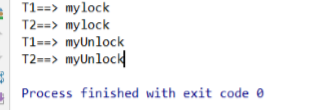
# 死锁⭐
死锁是什么
 死锁测试,怎么排除死锁:
死锁测试,怎么排除死锁:
public class DeadLockDemo {
public static void main(String[] args) {
String lockA = "lockA";
String lockB = "lockB";
new Thread(new MyThread(lockA, lockB), "T1").start();
new Thread(new MyThread(lockB, lockA), "T2").start();
}
}
class MyThread implements Runnable{
private String lockA;
private String lockB;
public MyThread(String lockA, String lockB) {
this.lockA = lockA;
this.lockB = lockB;
}
@Override
public void run() {
synchronized (lockA){
System.out.println(Thread.currentThread().getName() + "lock:"+lockA+"=>get"+lockB);
try {
TimeUnit.SECONDS.sleep(2);
} catch (InterruptedException e) {
e.printStackTrace();
}
synchronized (lockB){
System.out.println(Thread.currentThread().getName() + "lock:"+lockB+"=>get"+lockA);
}
}
}
}
解决问题⭐
1、使用 jps -l 定位进程号
cmd 窗口 输入 jps -l
 2、使用 jstack 进程号 找到死锁问题
2、使用 jstack 进程号 找到死锁问题


